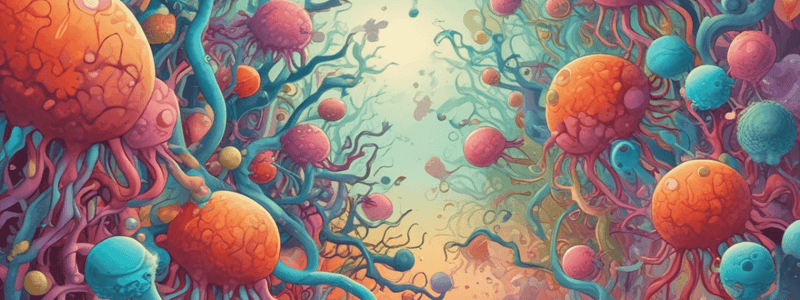Podcast
Questions and Answers
What is a possible symptom of an infectious disease that impacts the brain or nervous system?
What is a possible symptom of an infectious disease that impacts the brain or nervous system?
- Difficulty with walking (correct)
- Vomiting
- Rash formation
- Weight loss
What is the main difference between infection and disease in terms of etiology?
What is the main difference between infection and disease in terms of etiology?
- Infections are caused by internal factors, while diseases are caused by external factors
- Infections are caused by antibiotics, while diseases are caused by viruses
- Infections are always caused by external pathogens, while diseases can be caused by internal or external factors (correct)
- Infections are caused by genetic mutations, while diseases are caused by bacteria
What is an example of a disease caused by a type of Lentivirus?
What is an example of a disease caused by a type of Lentivirus?
- HIV (correct)
- Chlamydia
- Toxoplasmosis
- Meningococcal disease
What is the term for abnormal growths of mutated tissues that destroy healthy tissues?
What is the term for abnormal growths of mutated tissues that destroy healthy tissues?
What is the term for infections caused by microorganisms that do not normally cause disease in a person with a properly functioning immune system?
What is the term for infections caused by microorganisms that do not normally cause disease in a person with a properly functioning immune system?
What is the term for the ability of a pathogen to invade and cause illness in another organism?
What is the term for the ability of a pathogen to invade and cause illness in another organism?
Which of the following is an example of a non-living agent that can cause infection?
Which of the following is an example of a non-living agent that can cause infection?
What is the term for the process by which harmful agents invade another organism and cause illness?
What is the term for the process by which harmful agents invade another organism and cause illness?
Which of the following is a common route of transmission for pathogens?
Which of the following is a common route of transmission for pathogens?
What is the term for the symptoms caused by the immune system's response to an infection?
What is the term for the symptoms caused by the immune system's response to an infection?
What is the primary characteristic that distinguishes parasites from other infectious agents?
What is the primary characteristic that distinguishes parasites from other infectious agents?
What is the main difference between an infection and a disease?
What is the main difference between an infection and a disease?
What is the primary mechanism by which prions proliferate?
What is the primary mechanism by which prions proliferate?
What is the common characteristic of rheumatoid arthritis, Huntington's disease, and cancer?
What is the common characteristic of rheumatoid arthritis, Huntington's disease, and cancer?
What is the primary outcome of the battle between pathogens and immune cells during an infectious disease?
What is the primary outcome of the battle between pathogens and immune cells during an infectious disease?
Flashcards are hidden until you start studying


